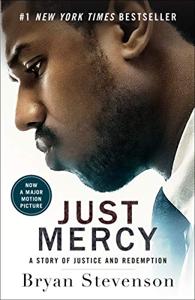
Want to learn the ideas in Just Mercy better than ever? Read the world’s #1 book summary of Just Mercy by Bryan Stevenson here.
Read a brief 1-Page Summary or watch video summaries curated by our expert team. Note: this book guide is not affiliated with or endorsed by the publisher or author, and we always encourage you to purchase and read the full book.
Video Summaries of Just Mercy
We’ve scoured the Internet for the very best videos on Just Mercy, from high-quality videos summaries to interviews or commentary by Bryan Stevenson.
1-Page Summary of Just Mercy
Overall Summary
Bryan Stevenson is a lawyer who founded the Equal Justice Initiative, an organization that helps people in prison. He also wrote a book called Just Mercy: A Story of Justice and Redemption. The memoir includes his story as well as statements against racial injustice and calls for reform to the American criminal justice system.
The U.S. prison population increased from 300,000 to 2,300,000 between the 1970s and 2014 as a result of tough sentencing laws and an increase in crime rates over that period. The majority of those incarcerated are Black or Hispanic. Many people who’ve been convicted for drug offenses often receive long sentences even though they may not have committed violent crimes; many of them are mentally ill or suffer from substance abuse problems which make it hard for them to defend themselves properly in court.
The narrative backbone of the book is Walter McMillian’s story. He was falsely accused of murdering a white woman in Alabama, where To Kill a Mockingbird takes place. The author discusses his trial and conviction as well as other cases where people were wrongfully persecuted, such as Charlie, who was sentenced to life in prison for killing his mother’s abusive boyfriend when he was 14 years old. Taken together, these stories ask readers to consider the idea that justice is more important than money or power.
Stevenson is a lawyer by the start of the first chapter, “Mockingbird Players”. He has defended McMillian for murder. However, there isn’t any solid evidence to prove that he’s guilty of murdering Ronda Morrison. The accusations are based on political machinations and implicit bias against an African American man who was having an affair with a white woman.
The author presents the cases of other people who have been treated unfairly and exposes how they were discriminated against.
This book provides several examples of police brutality and racial profiling, including an incident the author himself experienced. It also describes the struggles veterans face in getting proper medical care, as well as how juveniles are tried for crimes they didn’t commit.
Chapter 8 introduces readers to Tracy, Ian, and Antonio. They’re three people who served time in jail for non-homicidal crimes. They tell their stories about how they were treated by the justice system as children of color differently from white kids with similar issues. At fourteen years old, Antonio Nunez was the youngest person sentenced to death in U.S history for a crime that didn’t physically hurt anyone else.
The next chapter focuses on the poor and mentally ill prison population. They make up more than half of those who are currently incarcerated, but they’re not getting the help that they need in a system that’s not equipped to handle mental health issues. The case study is Avery Jenkins, who committed murder during a psychotic episode. Through Stevenson’s interventions, he was eventually moved to a mental health facility better equipped to care for him.
Chapter 12 discusses the situation of impoverished women who are imprisoned for having too many children. Chapter 14 focuses on physically, cognitively, and behaviorally disabled children who end up in prison. Finally, Chapter 16 ends with a positive note as the U.S Supreme Court announced that life imprisonment without parole sentences given to children convicted of non-homicidal crimes is cruel and unusual punishment.
The case of Walter McMillian is a long one. It spans from the 1980s to his release in 1993. The story goes that he was charged with murder and sentenced to death before he even went to trial, which is highly unusual. He was moved out of his hometown where most people knew him and into another town because it had a wealthier population who were less likely to know him or be biased against him based on skin color. Additionally, there were several eyewitness accounts that proved he wasn’t at the scene of the crime when it occurred so they ignored those as well as police misconduct (including paid testimony) and perjury among witnesses, all leading up to his conviction for murder after only three hours of deliberation by jurors despite being innocent.






